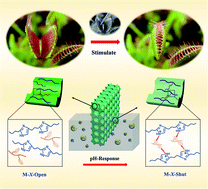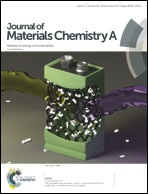A Venus-flytrap-inspired pH-responsive porous membrane with internal crosslinking networks†
Abstract
A Venus-flytrap-inspired pH-responsive polybenzimidazole (PBI) porous membrane is designed and fabricated for flow battery application. In the design, PBI membranes with tunable pores are firstly created by introducing hydrophilic sulfonated poly(ether ether ketone) (SPEEK) into the casting solution. Then internal crosslinking networks are built on the pore walls by in situ acid–base reaction between PBI and SPEEK to improve membrane selectivity, while keeping high conductivity. The in situ acid–base reaction process closely resembles the trapping mechanism of the Venus flytrap plant, whose lobes close when they sense contact with an external force. Moreover, a vanadium flow battery (VFB) with the resultant membrane exhibits outstanding battery performance with a coulombic efficiency of 99.5% and an energy efficiency of 89.1% at a current density of 80 mA cm−2, which are much higher than for commercial Nafion 115 (93.4%, 82.5%). Most importantly, a VFB with the prepared membrane keeps stable after continuously running for more than 10 000 cycles at a current density of 140 mA cm−2, showing super-high stability. This work provides a simple and biomimetic strategy to fabricate membranes with high conductivity and stability.



 Please wait while we load your content...
Please wait while we load your content...